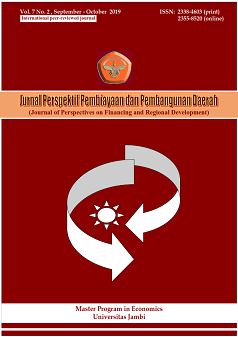Toward a tourism destination brand equity of coastal tourism of Pangandaran Regency
DOI:
https://doi.org/10.22437/ppd.v7i2.7483Abstract
Indonesia is one of the countries where tourism is the major contributors to the GDP. There are province and districts in Indonesia that mainly focused on the tourism business, Pangandaran is one of them. As a new district, Pangandaran is still trying to develop its brand as a tourist destination. This study aims to provide perceptual maps of Pangandaran as a brand compared to other coastal tourism destination. The study used Multidimensional Scaling (MDS), to inquire about the brand image of various coastal destination in Indonesia among domestic tourist. Two dimensions consisted of performance and value are used to measure the destination brand. More profound questions are also asked to inquire about factors that may influence tourist visitation. The result indicates that the Pangandaran brand as a tourism destination is perceived as a domestic oriented destination. A suggestion based on five steps of brand building is proposed to improve Pangandaran
Downloads
References
Ashley, C., De Brine, P., Lehr, A., & Wilde, H. (2007 ). The Role of Tourism Sector in Expanding Economic Opportunity. Cambridge: Kennedy School of Government, Harvard University.
Assaker, G., Vincenzo, E. V., & O'Connor, P. (2011). Modelling a causality network for tourism development: An empirical analysis. Journal of Modelling in Management, 6(3), 258-278.
Balakrishnan, M. S. (2009). Strategic branding of destinations: a framework. European Journal of Marketing, 43(5), 611-629.
Benur, A. M., & Bramwell, B. (2015). Tourism product development and product diversification in destinations. Tourism Management, 50, 213–224.
Campelo, A., Aitken, R., Thyne, M., & Gnoth, J. (2013). Sense of Place: The Importance for Destination Branding. Journal of Travel Research, 53(2), 154-166.
Claveria, O., & Polluzi, A. (2016). Positioning and clustering of the world's top tourist destinations by means of dimensionality reduction techniques for categorical data. Journal of Destination Marketing and Management, 6(1), 22-32
Dinas Pariwisata dan Kebudayaan Kabupaten Pangandaran. (2017). Data Kunjungan Wisata. Retrieved October 20, 2017, from Dinas Pariwisata dan Kebudayaan Kabupaten Pangandaran. Available at: http://dispar.pangandarankab.go.id
Dritsakis, N. (2004). Tourism as a Long-Run Economic Growth Factor: An Empirical Investigation for Greece Using Causality Analysis. Tourism Economics, 10(3), 305–316.
Durbarry, R. (2002). The Economic Contribution of Tourism in Mauritius. Annals of Tourism Research, 29(3), 862–865.
Evangelista, F., & Dioko, L. A. (2011). Interpersonal influence and destination brand equity perceptions. International Journal of Culture, Tourism and Hospitality Research, 5(3), 316-328.
Gartner, W. C. (1989). Tourism Image: Attribute Measurement of State Tourism Product Using Multidimensional Scaling Techniques. Journal of Tourism Research, 28(2), 16-20.
Gartner, W. C. (2014). Brand equity in a tourism destination. Place Branding and Public Diplomacy, 10(2), 108-116.
Lassar, W., Mittal, B., & Sharma, A. (1995). Measuring customerâ€based brand equity. Journal of Consumer Marketing, 12(4), 11–19.
LPEM-FEBUI . (2018). Kajian Dampak Sektor Pariwisata Terhadap Perkenomian Indonesia. Jakarta: LPEM-FEBUI .
Lim, Y., & Weaver, P. A. (2014). Customer-based Brand Equity for a Destination: the Effect of Destination Image on Preference for Products Associated with a Destination Brand. International Journal of Tourism Research, 16(3), 223-231.
Pike, S. (2005). Tourism destination branding complexity. Journal of Product & Brand Management, 14(4), 258–259.
Pike, S. (2009). Destination Branding Case Study: Tracking Brand Equity for an Emerging Destination Between 2003 and 2007. Journal of Hospitality & Tourism Research, 34(1), 124-139.
Saeed, N., Nam, H., Haq, M. I. U., & Muhammad Saqib, D. B. (2018). A Survey on Multidimensional Scaling. ACM Computing Surveys, 51(3), 1–25.
World Economic Forum. (2017). The Travel & Tourism Competitiveness Report. Geneva: World Economic Forum.
Downloads
Published
How to Cite
Issue
Section
License
Copyright (c) 2019 Ibrahim Rashid

This work is licensed under a Creative Commons Attribution 4.0 International License.

















